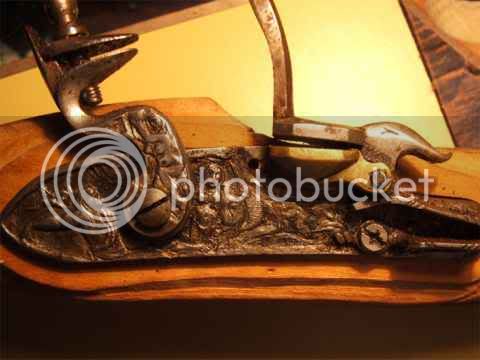The frizzen should be 10 degrees to the rear of vertical, or 80 degrees. Your frizzen is bent in the middle, rather than beginning just above the bottom of the frizzen. Its way too straight( vertical) for the bottom half to give you good sparks, or to pop open properly to let the sparks you do get be thrown down into the pan. Use an existing commercial lock to measure the angles with a protractor.
The point of contact of the front edge of the flint( new) should be between 60 and 66% above the bottom of the frizzen, in order to get good sparking. Most cocks are not angled forward enough to produce this angle, and have to be heated, and bent downward to get this angle correct. The new T/C lock has the hammer at the correct angle to the frizzen, as an example. The old flintlock was not made at the correct angle.
In using kasenite, bring the heat up to orange white, and sprinkle the casenite liberally on the face of the frizzen. Let it boil and bubble on the steel, and don't be afraid of adding more. Try to hold it there in the heat for at least 5 minutes.
Then, drop the frizzen immediately into a can of cold water held as close to the bottom of the frizzen when you remove the heat, as possible, so there is no time for the frizzen to air cool beofre hitting the water. The water will make the scale from the heating pop off the face of the frizzen. After you do your file test, you need to put the frizzen into your oven at 350 degrees for an hour, and let it cool slowly to room temperature. tap it with a piece of hard steel, like the shank of a screwdriver,and listen to the sound produced. The hardened frizzen, fresh out of the water quench, will give you a slight ring( "ting"). After its been tempered in the oven, it should give you a duller sound("tick").
Polish the face of the frizzen with emery cloth to remove any remaining scale, clear the pivot hole of any burrs, or debris, oil and replace it in your lock to try. If it doesn't spark, it because you did not get it HOT enough during the hardening and " case hardening " process. Heat it up again, only turn down the lights so you can really see the colors better, and get it to the orange/white hot color stage, before putting casenite on it again. Put the torch on the front side of the frizzen, which should be on the bottom when the frizzen is held in a bench vise by the tab with the pivot hole in it. The face of the frizzen should be facing up. Since heat rises, the hottest part of the frizzen will be the face, where you sprinkle the casenite, and watch it boil and bubble.
I prefer to have a second person on hand to help hold the torch in place, and/or hold the can or bucket of water up as close as possible to the frizzen when I release the jaws of the vice to let it fall into the water to quench. I have done this all by myself, but it gets to be a bit of a chinese fire drill without the extra hands. :rotf: :thumbsup:





